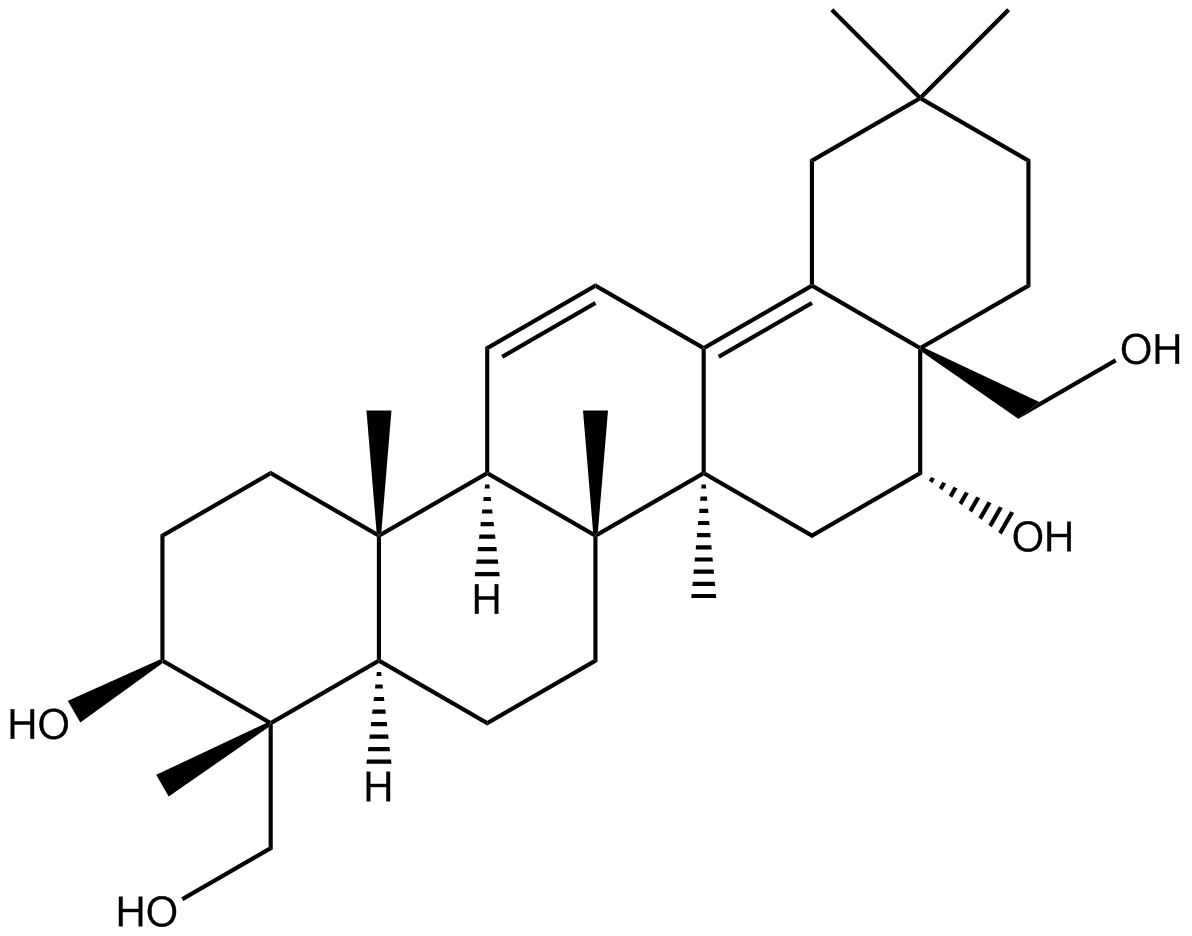
Saikogenin DCAS No.:5573-16-0
|
||||||||||
 |
|
|
||||||||

| Catalogue No.: | BP3723 |
| Formula: | C30H48O4 |
| Mol Weight: | 472.71 |
Product name: Saikogenin D
Synonym name:
Catalogue No.: BP3723
Cas No.: 5573-16-0
Formula: C30H48O4
Mol Weight: 472.71
Botanical Source:
Physical Description:
Type of Compound: Triterpenoids
Purity: 95%~99%
Analysis Method: HPLC-DAD or/and HPLC-ELSD
Identification Method: Mass, NMR
Packing: Brown vial or HDPE plastic bottle
Storage: Store in a well closed container, protected from air and light. Put into refrigerate or freeze for long term storage.
The product could be supplied from milligrams to grams
Inquire for bulk scale.
For Reference Standard and R&D, Not for Human Use Directly.
Description:
Saikogenin D possesses a dual effect: an inhibition of A23187-induced PGE2 production without a direct inhibition of cyclooxygenase activity; and an elevation of [Ca2+]i that is attributed to Ca2+ release from intracellular stores. Saikogenin D has immunomodulatory effect, it can attenuate IL-6 production in LPS-stimulated alveolar macrophages of B6 more than in that of BALB.
References:
Planta Medica, 2003, 69(8):765.
Dual effect of saikogenin D: in vitro inhibition of prostaglandin E2 production and elevation of intracellular free Ca2+ concentration in C6 rat glioma cells.
To clarify the pharmacological profile of Saikogenin D, we examined the effect of Saikogenin D on prostaglandin E2 (PGE2) production and intracellular free Ca2+ concentration ([Ca2+]i) in C6 rat glioma cells.
METHODS AND RESULTS:
Saikogenin D (1-20 microM) inhibited PGE2 production induced by the Ca2+ ionophore A23187 in a concentration-dependent manner with the IC50 of about 3 microM. Saikogenin D did not affect the conversion of arachidonic acid into PGE2 in microsomal preparations. On the other hand, Saikogenin D elevated [Ca2+]i in a concentration-dependent manner (10-100 microM) with the EC50 value of about 35 microM in the presence or absence of extracellular Ca2+.
CONCLUSIONS:
These results suggest that Saikogenin D possesses a dual effect: an inhibition of A23187-induced PGE2 production without a direct inhibition of cyclooxygenase activity; and an elevation of [Ca2+]i that is attributed to Ca2+ release from intracellular stores.
International Immunopharmacology, 2002, 2(2–3):357-366.
The herbal medicine Shosaiko-to exerts different modulating effects on lung local immune responses among mouse strains
Shosaiko-to (SST), a Chinese/Japanese traditional herbal medicine, has recently been demonstrated to increase lung interleukin-6 (IL-6) levels and to ameliorate pulmonary disorders in BALB/c mice (BALB).
METHODS AND RESULTS:
In the present study, we examined the effects of SST on lung cytokine levels and lipopolysaccharide (LPS)-induced lung injury in C57BL/6 mice (B6), which are known to show different immune responses from BALB due to the difference in genetic backgrounds. In B6, in contrast with BALB, SST decreased lung IL-6 levels and exacerbated LPS-induced lung injury. Investigation of the active components of SST suggested that multiple ingredients were supposed to be responsible for IL-6-attenuating activity in vivo. Further, we examined the effect of metabolites of major ingredients of SST on IL-6 production from lung immune cells in vitro. Saikogenin D and oroxylin A attenuated IL-6 production in LPS-stimulated alveolar macrophages of B6 more than in that of BALB. Liquiritigenin, which was previously reported to enhance IL-6 production in anti-CD3 monoclonal antibody-stimulated lung mononuclear cells of BALB, showed no effect on that of B6.
CONCLUSIONS:
These findings suggest that SST may have different, possibly even opposite, effects on lung immunity in hosts with different genetic backgrounds.